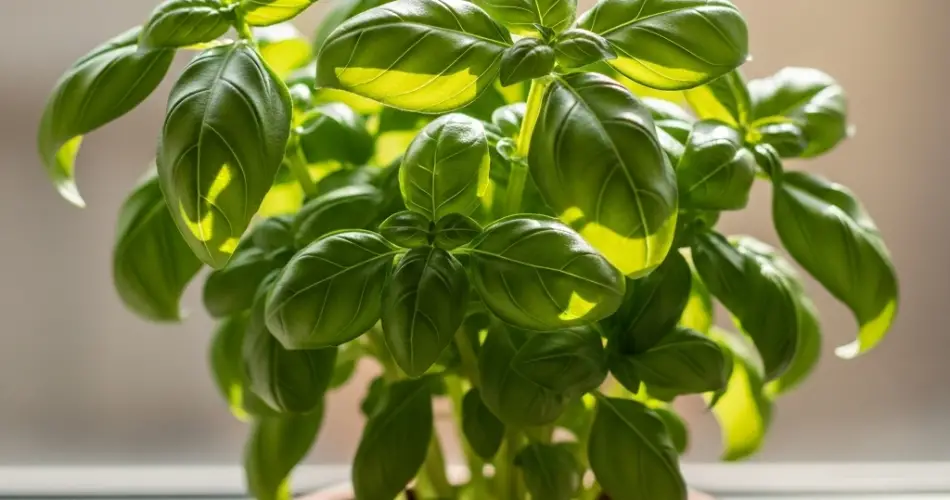Basil is a favorite in herb gardens for its fragrant leaves and versatile culinary uses. While it’s relatively easy to grow, basil can fall prey to various fungal diseases, especially in warm, humid environments. These fungal infections can cause yellowing leaves, black spots, mold, and stunted growth, affecting both the plant’s appearance and flavor.
Fortunately, there are natural and effective ways to manage and prevent fungal diseases in basil without resorting to harsh chemicals. Here’s how to recognize common fungal issues and treat them using organic methods.
Common Fungal Diseases in Basil
1. Downy Mildew
Symptoms:
-
Yellowing leaves with dark, fuzzy growth on the undersides
-
Leaves curl and fall off prematurely
-
Slows overall growth
Cause:
Downy mildew is caused by a water mold (Peronospora belbahrii) that thrives in humid, shaded conditions with poor air circulation.
Natural Solutions:
-
Improve air flow: Space plants properly and prune excess growth.
-
Water at the base to avoid wetting the leaves.
-
Apply neem oil spray once or twice a week to prevent and control spread.
-
Remove and destroy infected leaves immediately.
Prevention Tip: Grow basil in full sun to reduce humidity on foliage and avoid overhead watering.
2. Fusarium Wilt
Symptoms:
-
Yellowing and wilting leaves, often starting on one side
-
Stunted or distorted growth
-
Dark streaks on stems
Cause:
Fusarium wilt is a soil-borne fungal disease caused by Fusarium oxysporum, often present in contaminated soil or introduced through infected seeds.
Natural Solutions:
-
Remove and discard infected plants; do not compost.
-
Rotate crops and avoid planting basil in the same soil each season.
-
Improve drainage and avoid overwatering.
-
Use disease-resistant basil varieties, such as ‘Nufar’.
Prevention Tip: Sterilize containers and tools between uses to avoid transferring fungal spores.
3. Gray Mold (Botrytis)
Symptoms:
-
Soft, gray, fuzzy mold on leaves or stems
-
Dark spots and tissue decay
-
Rapid plant collapse in humid conditions
Cause:
Gray mold is caused by Botrytis cinerea, a fungus that spreads quickly in high humidity and low light.
Natural Solutions:
-
Increase ventilation and provide plenty of light.
-
Remove infected plant parts as soon as mold appears.
-
Spray with diluted hydrogen peroxide solution (1 tablespoon per cup of water) to kill fungal spores.
-
Avoid overcrowding plants to reduce moisture buildup.
Prevention Tip: Keep foliage dry and clean fallen leaves from soil surface.
4. Leaf Spot
Symptoms:
-
Small black or brown spots with yellow halos
-
Premature leaf drop
-
Leaves may appear distorted or deformed
Cause:
Leaf spot can be caused by several fungi, most commonly Colletotrichum or Alternaria species, often thriving in moist environments.
Natural Solutions:
-
Prune affected leaves and dispose of them far from the garden.
-
Apply compost tea or copper-free fungicidal sprays approved for organic gardening.
-
Maintain healthy soil with good drainage and organic matter.
Prevention Tip: Avoid getting leaves wet while watering and maintain proper plant spacing.
General Tips to Prevent Fungal Infections in Basil
Even without specific symptoms, these tips will reduce the risk of disease and keep your basil plants strong and productive:
1. Water Smartly
Water at the base of the plant early in the day to prevent standing water on the leaves overnight. Avoid watering during the evening when temperatures drop and moisture lingers.
2. Ensure Good Air Circulation
Proper spacing between plants allows airflow, reducing humidity that encourages fungal growth. Regularly prune your basil to promote healthy structure and light penetration.
3. Use Clean Tools and Containers
Always sanitize garden tools before pruning or harvesting basil. If reusing pots, clean them thoroughly with soap and hot water to remove any lingering fungal spores.
4. Choose the Right Soil
Basil prefers well-draining, rich soil. Avoid compacted or overly moist soil, which can harbor fungal pathogens. Add compost or perlite to improve drainage.
5. Rotate Crops
Avoid planting basil in the same location season after season. Crop rotation helps reduce the buildup of soil-borne fungi and maintains a healthy growing environment.
6. Consider Companion Planting
Plant basil near herbs and vegetables like tomatoes, peppers, and oregano, which have similar care needs. Some of these companions help repel pests and promote healthy growth, indirectly reducing fungal risk.
Organic Sprays to Try
Here are a few natural sprays that can help prevent and control fungal issues:
-
Neem Oil: Effective against a wide range of fungi and pests. Mix with water and a few drops of dish soap.
-
Baking Soda Spray: Mix 1 teaspoon baking soda with 1 quart of water and a drop of mild soap.
-
Hydrogen Peroxide Solution: Mix 1 tablespoon of 3% hydrogen peroxide with 1 cup of water to spray on affected leaves.
Always test sprays on a small section of the plant first to ensure there’s no adverse reaction.
Conclusion
Fungal diseases can be frustrating for basil growers, but they don’t have to mean the end of your harvest. With a few proactive steps and natural remedies, you can treat infections organically and prevent future outbreaks. Keep your basil in sunny, well-ventilated spaces, water wisely, and respond quickly to any signs of trouble. Your efforts will be rewarded with lush, flavorful leaves all season long.



